The Mate 20 & Mate 20 Pro Review: Kirin 980 Powering Two Contrasting Devices
by Andrei Frumusanu on November 16, 2018 8:10 AM EST- Posted in
- Smartphones
- Huawei
- Mobile
- Kirin 980
- Mate 20
- Mate 20 Pro
Kirin 980 Second Generation NPU - NNAPI Tested
We’ve tested the first generation Kirin NPU back in January in our Kirin 970 review – Back then, we were quite limited in terms of benchmarking tests we were able to run, and I mostly relied on Master Lu’s AI test. This is still around, and we’ve also used it in performance testing Apple’s new A12 neural engine. Unfortunately or the Mate 20’s, the benchmark isn’t compatible yet as it seemingly doesn’t use HiSilicon’s HiAI API on the phones, and falls back to a CPU implementation for processing.
Google had finalised the NNAPI back in Android 8.1, and how most of the time these things go, we first need an API to come out before we can see applications be able to make use of exotic new features such as dedicated neural inferencing engines.
“AI-Benchmark” is a new tool developed by Andrey Ignatov from the Computer Vision Lab at ETH Zürich in Switzerland. The new benchmark application, is as far as I’m aware, one of the first to make extensive use of Android’s new NNAPI, rather than relying on each SoC vendor’s own SDK tools and APIs. This is an important distinction to AIMark, as AI-Benchmark should be better able to accurately represent the resulting NN performance as expected from an application which uses the NNAPI.
Andrey extensive documents the workloads such as the NN models used as well as what their function is, and has also published a paper on his methods and findings.
One thing to keep in mind, is that the NNAPI isn’t just some universal translation layer that is able to magically run a neural network model on an NPU, but the API as well as the SoC vendor’s underlying driver must be able to support the exposed functions and be able to run this on the IP block. The distinction here lies between models which use features that are to date not yet supported by the NNAPI, and thus have to fall back to a CPU implementation, and models which can be hardware accelerated and operate on quantized INT8 or FP16 data. There’s also models relying on FP32 data, and here again depending on the underlying driver this can be either run on the CPU or for example on the GPU.
For the time being, I’m withholding from using the app’s scores and will simply rely on individual comparisons between each test’s inference time. Another presentational difference is that we’ll go through the test results based on the targeted model acceleration type.

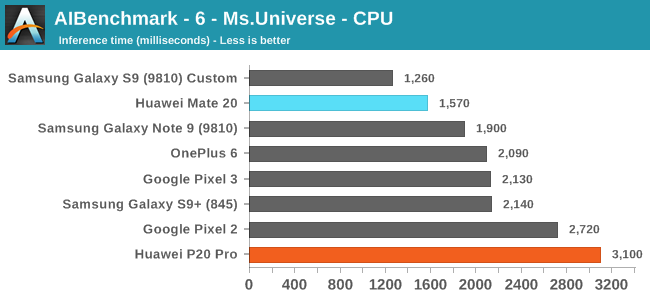
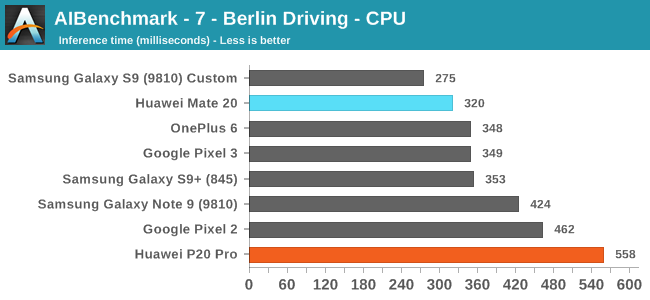
The first three CPU tests rely on models which have functions that are not yet supported by the NNAPI. Here what matters for the performance is just the CPU performance as well as the performance response time. The latter I mention, because the workload is transactional in its nature and we are just testing a single image inference. This means that mechanisms such as DVFS and scheduler responsiveness can have a huge impact on the results. This is best demonstrated by the fact that my custom kernel of the Exynos 9810 in the Galaxy S9 performs significantly better than the stock kernel of the same chip of the Note9 in the same above results.
Still, comparing the Huawei P20 Pro (most up to date software stack with Kirin 970) to the new Mate 20, we see some really impressive results of the latter. This both showcases the performance of the A76 cores, as well as possibly improvements in HiSilicon’s DVFS/scheduler.
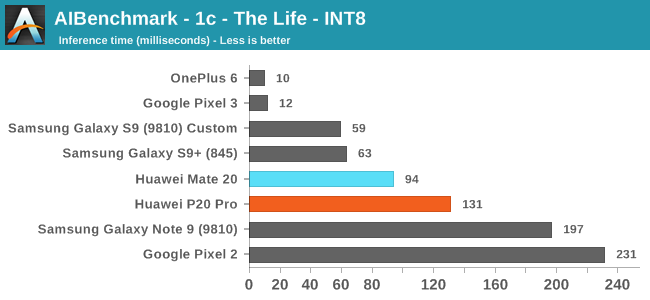
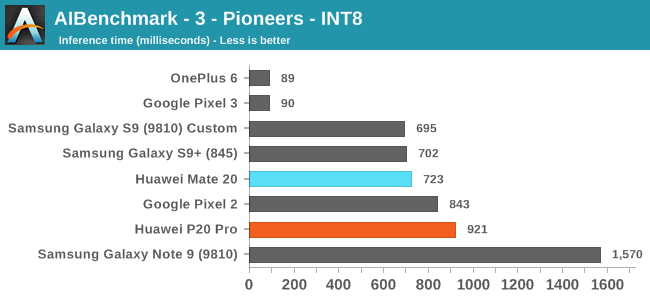
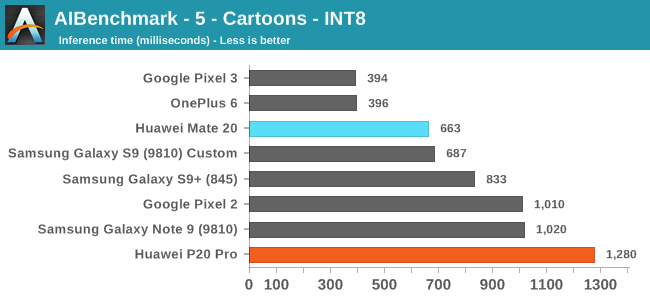
Moving onto the next set of tests, these are based on 8-bit integer quantized NN models. Unfortunately for the Huawei phones, HiSilicons NNAPI drivers still doesn’t seem to expose acceleration to the hardware. Andrey had shared with me that in communications with Huawei, is that they plan to rectify this in a future version of the driver.
Effectively, these tests also don’t use the NPU on the Kirins, and it’s again a showcase of the CPU performance.
On the Qualcomm devices, we see the OnePlus 6 and Pixel 3 far ahead in performance, even compared to the same chipset Galaxy S9+. The reason for this is that both of these phones are running a new updated NNAPI driver from Qualcomm which came along with the Android 9/P BSP update. Here acceleration if facilitated through the HVX DSPs.
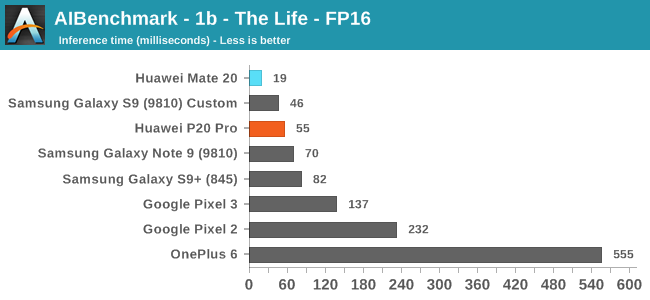
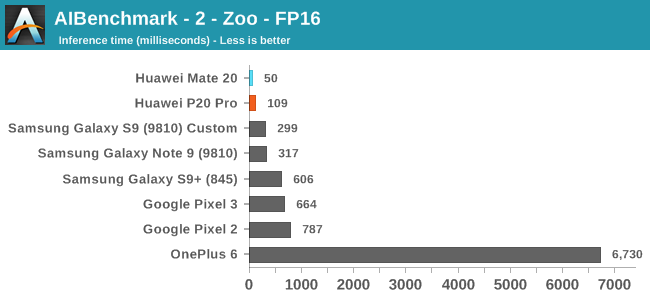
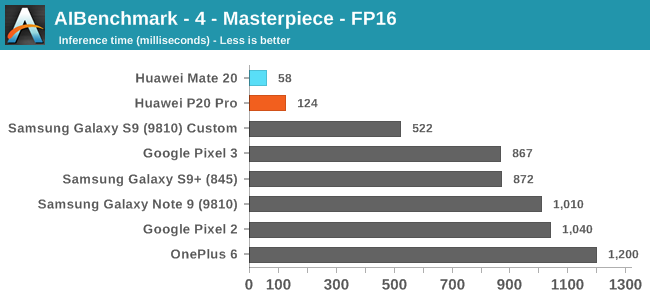
Moving on to the FP16 tests, here we finally see the Huawei devices make use of the NPU, and post some leading scores both on the old and new generation SoCs. Here the Kirin 980’s >2x NPU improvement finally materialises, with the Mate 20 showcasing a big lead.
I’m not sure if the other devices are running the workloads on the CPU or on the GPU, and the OnePlus 6 seems to suffer from some very odd regression in its NNAPI drivers that makes it perform an order of magnitude worse than other platforms.

Finally on the last FP32 model test, most phones should be running the workload on the CPU again. There’s a more limited improvement on the part of the Mate 20.
Overall, AI-Benchmark was at least able to validate some of Huawei’s NPU performance claims, even though that the real conclusion we should be drawing from these results is that most devices with NNAPI drivers are currently just inherently immature and still very limited in their functionality, which sadly enough again is a sad contrast compared where Apple’s CoreML ecosystem is at today.
I refer back to my conclusion from early in the year regarding the Kirin 970: I still don’t see the NPU as something that obviously beneficial to users, simply because we just don’t have the software applications available to make use of the hardware. I’m not sure to what extent Huawei uses the NPU for camera processing, but other than such first-party use-cases, NPUs currently still seems something mostly inconsequential to device experience










141 Comments
View All Comments
Sam31840 - Friday, November 16, 2018 - link
I m confused ! Most websites consider that the mate 20 is excellent for photography, but according to anandtech review the results are not that good and below Pixel 3, iPhone X, etc. Who is right !s.yu - Saturday, November 17, 2018 - link
There are too many amateurs posting BS out on the web, Andrei examines samples very carefully and writes responsibly, a very rare feat in this day.In fact for almost all the reviews out there who provide full samples, either they cannot completely endorse the Huawei flagships(caveats are always ugly sharpening and extremely excessive NR, sometimes other instabilities and artifacts), or if they can, their conclusions can be disputed by closer scrutiny of their own samples provided. In which case they're either paid ads(which Huawei does both openly and secretly, a lot) or they don't actually have the necessary experience and/or training to be evaluating image quality.
Not to mention the sea of digital crap on youtube which have no merit whatsoever and only serve to mislead people more ignorant than the uploaders are.
shompa - Sunday, November 18, 2018 - link
most reviewers dont even have screens with 10bit uncompresses P3 wide color gamut. I never understood how all these reviewers with wrong color screens can do any real test of digital photography. There is a huge difference between what "looks good" and what have correct colors. Heck; 99%+ of Win PCs have screens with compressed/wrong colors. 2017 I could not find a single PC laptop with a color correct screen, something Apple had since 2015.s.yu - Tuesday, November 20, 2018 - link
In terms of assessing color, that is. Many already make enough mistakes regarding detail retention/noise reduction, DR, that's hardly anything to do with the screen.Sam31840 - Friday, November 16, 2018 - link
" The regular Mate 20’s camera is largely unimpressive and struggles to differentiate itself much from the competition. "melgross - Friday, November 16, 2018 - link
I find that a lot of sites really understand so little about photography that their conclusions are useless. Anandtech is better than most. I prefer professional photo sites in this, but not all bother with smartphones, and if they do, it’s usually just the Apple, Google and Samsung models.s.yu - Saturday, November 17, 2018 - link
I fully agree. DPR stayed out of the whole business by only uploading a few samples without a full review or comparison, most other sites are only good for their full size samples for personal comparison. Those without full size sample are almost totally useless.Lolimaster - Friday, November 16, 2018 - link
When the mate20X?Even the 5.8" screen of my S9 (actually 5.25"~ for 16:9, new wide phones only grew in vertical area) seems a bit on the small side.
Lolimaster - Friday, November 16, 2018 - link
Those screens of the Mate 20 should never leaved the factory and marked as defective.It's sad how people pay over $700 for a phone just to get a shitty screen. Companies are happy, people don't complain in mass from the main thing they will see everyday on their device.
mayankleoboy1 - Friday, November 16, 2018 - link
OTlinux kernel 4.20 has a 30% hit on Intel CPU's due to the STIBP mitigation
https://www.phoronix.com/scan.php?page=article&...